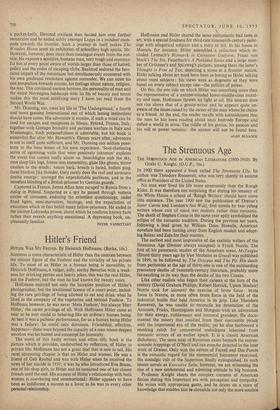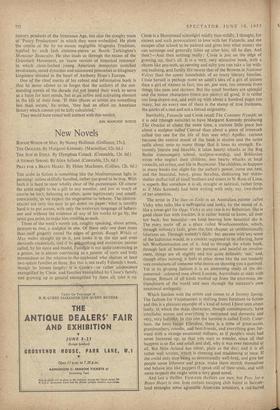The Strenuous Age
THE STAENUOUS AGE IN AMERICAN LITERATURE (1900-1910). By Grafit C. Knight. (0.U.P., 36s.) IN 1900 there appeared a book called The Strenuous Life. Its author was Theodore Roosevelt, who was very shortly to assume office as President of the United States.
No man ever lived his life more strenuously than the Rough Rider. It was therefore not surprising that during his tenancy of the White House a school of 'Rough Writers' should have come into existence. The year 1900 saw the publication of Dreiser's Sister Carrie and London's Sea Wolf, first novels by two yoting writers whose cast of mind was realistic rather than romantic. The death of Stephen Crane in the same year aptly symbolised the eclipse of the romantic tradition. During the previous ten years, following a lead given by William Dean Howells, American novelists had been turning away from English models and adopt- ing Balzac and Zola for their masters.
The earliest and most impressive of the realistic writers of the Strenuous Age (Dreiser always excepted) is Frank Norris. The first of his panoramic studies of the American scene, McTeague (filmed thirty years ago by Von Stroheim as Greed) was published in 1899, to be followed by The Octopus and The Pit. His death from peritonitis at the age of thirty-one is one of the outstanding premature deaths of twentieth-century literature, probably more far-reaching in its way than the deaths of the two Cranes.
Like other realists who began their careers at the turn of the century (David Graham Phillips, Robert Herrick, Upton Sinclair) Norris took for leitmotif the exercise of brute force : brute force in Nature, or more often brute force in the field of the industrial bustle that held America in its grip. Like Theodore Roosevelt, he was unable to reconcile his detestation of the Armours, Fricks, Huntingtons and Morgans with an admiration for their energy, ruthlessness and immoral grandeur. He docu- mented the misery that resulted from their mercantile piracy with the impersonal eye of the realist; yet he also harboured a sneaking relish for commercial melodrama inherited from romantic writers of an earlier epoch. It is a classic American dichotomy. The same taint of Byronism exists beneath the expres- sionistic trappings of O'Neill and can even dile detected in the later work of Dreiser. Only with the advent of Farrell and Dos Passos is the romantic regard for the commercial buccaneer exorcised, the nostalgic cult of the Superman finally extinguished. In such recent novels as Executive Suite, however, we are witnessing the rise of a new sentimental and admiring attitude to big business.
Professor Knight charts the complex currents of American fiction during this important era with perception and sympathy. He writes with appropriate gusto, and he draws on a store of knowledge that enables him to chronicle not only the more sombre literary products of the Strenuous Age, but also the doughy mass of Pastry Productions' in which they were embedded. He plots the course of the by no means negligible Magnolia Tradition, typified by such lush costume-pieces as Booth Tarkington's Monsieur Beaucaire. He also leads us through the mazes of the Graustark Movement, an 'inane version of historical romance' in which clean-limbed young American demperats scotched revolutions, saved dynasties and succoured princesses in imaginary kingdoms situated in the heart of Anthony Hope's Europe.
One of the chief merits of his robust and informative book is that he never allows us to forget that the authors of the out- standing novels of the decade did not intend their work to serve as a balm for hurt minds, but as an active and activating element in the life of their, time. 'If their places as artists are something less than secure,' he- writes, 'they had an effect on American history which cannot yet be fally calculated.'
They would have rested Well content with this verdict.
JON MANCHIP WHITE











































 Previous page
Previous page